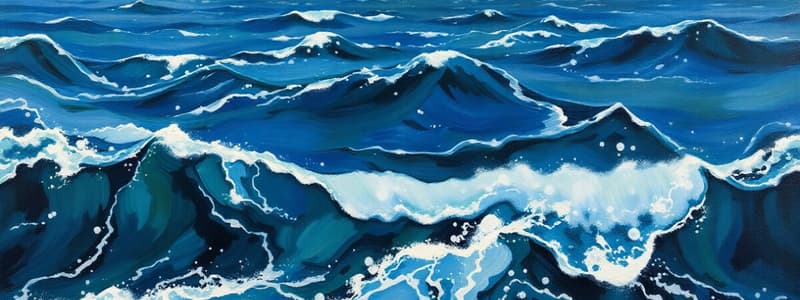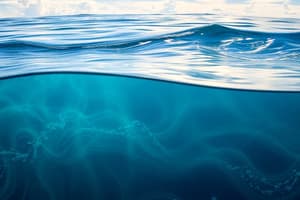Podcast
Questions and Answers
What primarily influences deep water currents in the ocean?
What primarily influences deep water currents in the ocean?
- Surface currents and ocean gyres
- Wind patterns and surface temperature
- The gravitational pull of the Moon only
- Differences in density caused by temperature and salinity (correct)
How does salinity affect the movement of water in ocean currents?
How does salinity affect the movement of water in ocean currents?
- Salinity only affects surface currents, not deep currents
- Higher salinity increases the density of water, causing it to sink (correct)
- Salinity does not influence water density
- Lower salinity causes water to sink more easily
What is the main characteristic of gyres in the northern hemisphere?
What is the main characteristic of gyres in the northern hemisphere?
- They rotate clockwise (correct)
- They rotate counterclockwise
- They are not affected by the Coriolis effect
- They do not have a significant impact on ocean currents
What causes thermohaline circulation, also known as the Global Conveyor Belt?
What causes thermohaline circulation, also known as the Global Conveyor Belt?
How do continents affect ocean currents?
How do continents affect ocean currents?
What phenomenon results from Earth's rotation affecting ocean currents?
What phenomenon results from Earth's rotation affecting ocean currents?
What is a key definition of 'gyres' in oceanography?
What is a key definition of 'gyres' in oceanography?
What primarily drives surface ocean currents?
What primarily drives surface ocean currents?
Which of the following is NOT a factor influencing ocean currents?
Which of the following is NOT a factor influencing ocean currents?
How deep do surface currents generally extend?
How deep do surface currents generally extend?
What phenomenon is the Coriolis Effect associated with in the context of ocean currents?
What phenomenon is the Coriolis Effect associated with in the context of ocean currents?
What is one primary effect of ocean currents on a regional scale?
What is one primary effect of ocean currents on a regional scale?
Which of the following statements about deep water currents is accurate?
Which of the following statements about deep water currents is accurate?
Which factor is most influential in determining the direction of surface ocean currents?
Which factor is most influential in determining the direction of surface ocean currents?
What can surface ocean currents carry that allows them to be observed from space?
What can surface ocean currents carry that allows them to be observed from space?
Flashcards
What is a current?
What is a current?
The movement of a fluid, like water or air.
What are ocean currents?
What are ocean currents?
Large-scale water movements within the Earth's oceans that span the globe.
What is the Coriolis Effect?
What is the Coriolis Effect?
The rotation of the Earth causes a deflection of moving objects, including ocean currents.
What are surface currents?
What are surface currents?
Signup and view all the flashcards
What is the main driver of surface currents?
What is the main driver of surface currents?
Signup and view all the flashcards
How does wind affect surface currents?
How does wind affect surface currents?
Signup and view all the flashcards
How can we see surface currents from space?
How can we see surface currents from space?
Signup and view all the flashcards
What are the effects of ocean currents?
What are the effects of ocean currents?
Signup and view all the flashcards
Gravity's Influence on Ocean Currents
Gravity's Influence on Ocean Currents
Signup and view all the flashcards
Coriolis Effect
Coriolis Effect
Signup and view all the flashcards
Gyres
Gyres
Signup and view all the flashcards
Continental Deflection
Continental Deflection
Signup and view all the flashcards
Deepwater Currents
Deepwater Currents
Signup and view all the flashcards
Thermohaline Circulation
Thermohaline Circulation
Signup and view all the flashcards
Global Conveyor Belt
Global Conveyor Belt
Signup and view all the flashcards
Study Notes
Ocean Currents
- Ocean currents are large-scale movements of water in the Earth's oceans.
- They are influenced by various factors, including Earth's rotation (Coriolis effect), wind, gravity, temperature, and salinity.
- Ocean currents significantly impact climate, temperatures, and global wind patterns by transporting heat.
Types of Ocean Currents
- Surface Currents: Occur in the upper layer of the ocean (up to ~400m).
- Primarily driven by wind, gravity, and the Coriolis Effect.
- Wind is the most significant driver.
- Friction between wind and water surface causes water movement.
- Currents' direction is influenced by landmasses and meeting other currents.
- Gravity influences currents based on water density differences (temperature and salinity).
- Ocean tides, caused by Earth-Moon-Sun gravitational interactions, also impact currents.
- The Coriolis Effect deflects currents, creating gyres.
- Gyres: Large circular patterns of water movement, influenced by continents, Earth's rotation, and the Coriolis effect.
- Five major gyres exist in the world's oceans (North/South Atlantic, North/South Pacific, Indian).
- Northern hemisphere gyres rotate clockwise, and southern hemisphere gyres rotate counterclockwise.
- Continents deflect currents changing their direction.
- Deep Water Currents: Occur in the deeper parts of the ocean.
- Driven by density differences (temperature and salinity).
- Thermohaline Circulation (Global Conveyor Belt): Driven by temperature (thermo) and salt content (haline) differences.
- Cold, salty water sinks, while warmer, less salty water rises.
- This creates a global circulation pattern that distributes heat and nutrients.
Studying That Suits You
Use AI to generate personalized quizzes and flashcards to suit your learning preferences.




